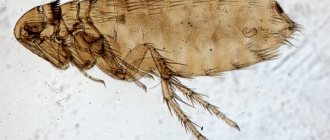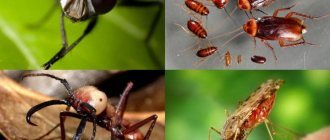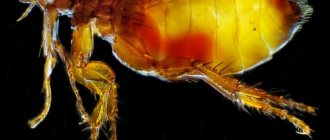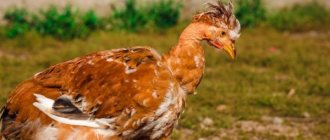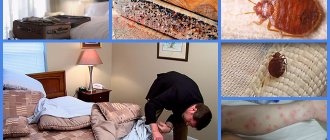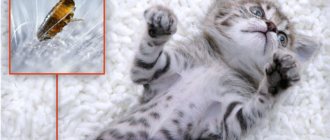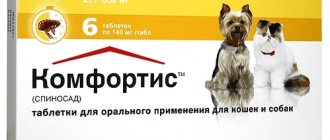Down eaters, mites and pigeon fleas live on almost all types of wild pigeons. Many of these parasites are carriers of worms and other intestinal infections. Infected birds can transmit their diseases to humans, causing serious damage to their health. Bird breeders need to be able to promptly identify the presence of harmful insects and promptly carry out sanitary and hygienic measures for destruction.
Varieties of pigeon parasites
Wild city pigeons live crowded in the attics of abandoned buildings and are not clean birds. They do not particularly monitor the condition of their plumage; they feed in landfills and trash bins, carrying dirt, which contains a large number of larvae of various harmful insects, to their nesting sites.
Once in a warm nest, the larvae emerging from the egg develop into adult parasites, which infect the chicks and are transmitted from bird to bird.
There are several main groups of insects that parasitize pigeons:
- down-eaters;
- fleas;
- blood-sucking flies;
- mites;
- bedbugs.
Parasites try to settle in the most inaccessible places on the birds’ bodies, especially on the back of the neck, where even long-billed pigeons cannot reach them.
A variety of worms can settle in the gastrointestinal tract of birds, the vital activity of which can significantly worsen the health of the bird.
Breeders of domestic breeds of pigeons should limit as much as possible the possibility of their pets interacting with wild birds. The latter should not be allowed to nest in close proximity to the dovecote, nor should they be allowed to fly into enclosures and feed from common feeders.
Description of pigeon fleas
Bird fleas are a type of common flea. They are distinguished by a longer body, flattened laterally. On their head you can see black dots of eyes and the likeness of a mustache. The color is dark brown. The body size of an adult parasite can reach 3 mm.
Most types of pigeon fleas are not dangerous to humans, but they can cause dangerous diseases in poultry and many warm-blooded pets.
Fleas do not have wings, so they cannot fly, but they are excellent jumpers. This ability helps them find their “breadwinners” at a distance of several meters.
Their favorite habitat is bird nests, where they breed. They also lay eggs on bird excrement and food remains, which are abundant in pigeon habitats: on unglazed balconies, in attics. Therefore, residents of the upper floors suffer most from them. The eggs hatch into larvae that look like small caterpillars with a pale color.
If bird nests are located near chimneys or other warm places, larvae may appear all year round. Under unfavorable conditions, the larvae are able to enter a state resembling hibernation. In this form, they can go without food for a long time. Even in the long-term absence of “breadwinners” - warm-blooded animals and birds - fleas are able to survive.
If the pigeons are in the nest, then the fleas are provided with food. When the birds fly away, insects enter apartments in search of food.
Under favorable conditions, the full development cycle of pigeon fleas is 20 days. This means that having destroyed one colony of insects, after 20 days you can expect the appearance of a new one.
Bird fleas naturally feed on the blood of wild and domestic birds. Birds develop anemia, which can lead to the death of entire flocks. Affected birds constantly clean and straighten their feathers and bathe in the sand. At this stage they can still be treated. But if severe loss of feathers and down begins, then it is too late to treat them. If there are no birds, parasites can feed on the blood of domestic animals.
Signs of human bites may include the appearance of small purplish-red spots on the body and itching.
Feather-eating mites
Experienced pigeon breeders understand that it is impossible to completely protect poultry from parasites. You should regularly examine your pets, trying to detect signs of life, even microscopic insects. To do this, you need to use a magnifying glass to examine the marks on the skin and the condition of the pigeons’ feathers.
Having a yellow-brown color, down-eaters can reach a length of 3 mm. They have powerful mouthparts. They feed on feather scales and flaking skin, causing the pigeon to itch.
If you notice that your pet bird is preening its feathers frequently and is acting restless, then it's time to start a thorough inspection of its plumage.
Due to the activity of these parasites, birds may begin to actively lose feathers, which will have a stitched appearance. In decorative individuals, fluff eaters like to live in the plumage of the paws, which loses its shine and beautiful appearance. It is impossible to eliminate insects without drug treatment.
Are there pigeon fleas?
Pigeon fleas are not a very common phenomenon; most often they are found in private houses where birds live and in apartments on the top floors if there are nests on the roof and a large concentration of pigeons.
Appearance
- Color – dark, almost black
- Size – up to 3 mm in length
- Body shape – elongated and flattened at the sides.
- The structure of the legs is that the third pair of legs is elongated, thanks to this the flea is able to jump high and far.
Development cycle
- Mature females lay eggs in birds' nests or in their excrement.
- The larvae are very pale caterpillar-like individuals; the favorable period for development is summer.
- The full cycle from egg laying to the emergence of the larvae ranges from 20 to 25 days, under favorable development conditions.
- During the cold season, fleas and already laid eggs fall into suspended animation and can remain in it for a long period of time.
Important. Pigeon fleas lead an active lifestyle only during the period when the birds are sitting in the nest. At this time, parasites mercilessly bite both adult birds and young offspring.
When birds leave the nests and fly to warmer regions, the fleas turn into pupae and remain in the nests until the birds return.
Why are fleas on pigeons dangerous for humans?
Bird fleas feed on blood; in the absence of birds for a long time, they begin to bite humans. These parasites can settle in a house or apartment and live for a long period of time without visible signs. Pigeon parasite bites can be recognized by the following symptoms:
- Severe pain in the bite area.
- Damage to the skin does not heal for a long time, sometimes turning from a simple wound into suppuration with a bluish tint.
- Immediately after the bites occur, allergies are observed in the form of:
- Elevated temperature;
- Severe itching;
- Chills and fever;
- Inflammation of the lymph nodes.
Pigeon fleas can act as carriers of various infections and diseases , such as:
- Typhoid
- Hepatitis
- Encephalitis
- brucellosis
Therefore, it is highly recommended not to self-medicate , especially if acute allergy symptoms appear on the body immediately after the bites. This may indicate the development of a dangerous disease and if treatment is not started in time, the consequences can be disastrous.
Signs of bird infection
There are a number of signs by which you can recognize whether a bird is infected with parasites or not :
- The bird's feathers are constantly frayed, which may indicate that it is bothered by bites and itching.
- The behavior of the bird is restless and aggressive. Frequent parasite bites make the bird nervous.
- Excessive loss of down and feathers indicates an advanced stage of the disease.
How and where can you get infected?
Considering that flocks of pigeons live in almost every yard, both in the city and in the countryside, the risk of bringing pigeon fleas into the house is very high for every person.
There is a high risk of infection:
- Through direct contact with birds (a pigeon pecked bread from a hand, sat on its head, and so on)
- Flea larvae can be carried into the house on shoes (very often they live in bird excrement)
- During the trip , visiting caves, grottoes and places with large concentrations of birds.
- If the balcony is not glazed , when birds have free access to the balcony, they can spend a long time there, shit, nest, and so on.
How to treat birds
Specialized pet stores offer a wide selection of products for feathered friends, the action of which is aimed at destroying parasites. Manufacturers offer different forms of preparations: you can spray the product as an aerosol, you can rub it into feathers , it all depends on the preferences of the buyer.
After treating birds, it is imperative to treat the latter’s habitat . This is done in order to avoid re-infection of birds.
The person handling the birds and cages must wear gloves, a cap and protective outerwear. Upon completion of the procedure, the person must wash his outer clothing and take a shower.
Pigeon fleas in an apartment: how to get rid of them
The room is treated with any insecticidal agent according to the instructions. During the period of action of the drug, the room must be left for a day. Then, upon returning, you should ventilate the room and do a wet cleaning. All surfaces are wiped with a soda solution.
In hard-to-reach places, you can leave some of the product for prevention. To obtain the expected effect, the treatment procedure will need to be repeated 10 - 14 days after the first one .
If there are fleas from pigeons on the balcony, then it also needs to be treated and glazed over time or periodically treated for preventive purposes.
If the apartment is on the top floor, and pigeons have settled on the roof, then you need to remove them from the roof and attic without causing harm to the birds. Then thoroughly treat their habitats and only after that begin disinfection in the apartment.
All types of parasites cannot tolerate the smell of wormwood; as a preventative measure, you can apply a few drops of wormwood essential oil to your shoes and clothes , and calmly go to feed the pigeons or travel through a cave.
How to treat pigeons for lice in the video below:
Source: https://hlopklop.com/blohi/golubinye-blohi.html
Fleas jumping from bird to bird
The most common type of parasite is fleas in pigeons, which have the ability to move from bird to bird by jumping. These insects feed exclusively on the blood of birds, biting through their skin with powerful jaws. They reach a length of 1-3 mm and have a dark body color, close to black.
Three pairs of paws perform different functions. With the help of the two front legs, parasites attach to the skin or plumage of the bird, and the more powerful hind pair of legs is responsible for moving in the form of jumping. Pigeon fleas are capable of jumping at a distance of up to 30 cm, guided by warmth. Due to very poor vision, they do not see the target, often ending up on the body of a person or pet.
Once in the birds' nest, they lay eggs, from which larvae develop within 20 days, resembling small pale caterpillars. The peak of development occurs during the period of raising offspring, which are immediately infected with this parasite.
The main feature of insects is that parasites living on pigeons can go without food for a long time. Their eggs and pupae remain viable for several months, waiting for the moment when a bird appears nearby to become a new host.
Signs of bird infection
Detecting the presence of fleas in birds is quite problematic. For a long time it seems that the pigeon is completely healthy. In fact, he may be amazed. Birds constantly clean their feathers, so owners do not attach any importance to this. If birds straighten their feathers all the time, they don't worry. And only during a period of increased feather loss does suspicion arise that the bird is sick.
It is quite possible that pigeons already have fleas if they:
- Constantly worried. Aggressive behavior is noted. With frequent insect bites, the bird begins to get nervous.
- Feathers and down fall out rapidly. This indicates that the disease is in an advanced stage.
- The bird looks disheveled. This indicates that the bird is bothered by itching and bites.
Dangerous for pets and humans
Bird fleas are capable of jumping onto pets and people who may bring them into the living area. Pigeon fleas that find their way into an apartment do not consider humans to be their main host, since the structure of the insect's legs does not allow it to stay firmly on the human body. Much more often the parasite prefers a dog, cat or parrot.
Nevertheless, fleas happily drink human blood, transmitting various infections received from their previous owners to people. Scientists assume that these parasites transmit pathogens of encephalitis, brucellosis, hepatitis, typhus and other infectious diseases. Read more in the article “What diseases does a pigeon carry and what are its benefits?”
Pigeon fleas leave small bite marks on the human body that are very itchy and difficult to heal. Over time, these places acquire a purple tint. There is itching and other symptoms of allergic reactions.
In most cases, the body copes with infections brought by fleas, but a person with a weakened immune system, especially children, may develop infectious diseases that will need to be treated with medications.
Reviews from pigeon owners about fleas
Owners of pigeons who are faced with the problem of fleas in their birds know well how dangerous these harmful insects are not only for birds, but also for people. They know for sure that a comprehensive fight is required, which must begin when the first signs of the presence of parasites are identified. Only in this case will it be possible to achieve excellent results. You can use different methods and purchase modern tools. It is only important to follow safety measures.
Getting rid of fleas on pigeons and other birds is very simple. Just don’t let this situation get worse, so as not to complicate life for yourself and the birds.
Dangerous blood-sucking flies
Diptera blood-sucking flies, or bloodsuckers, as pigeon breeders call them, are also dangerous. They are very aggressive and cause serious pain to birds with their bites.
Birds experiencing constant itching lose their appetite and may completely refuse to feed. Very often, because of bloodsuckers, pigeons stop hatching their chicks and leave the nest. The hatched babies suffer from anemia and are far behind their peers in development.
It makes no sense to treat such chicks until the blood-sucking flies are completely removed from the dovecote and their eggs are destroyed. Most often, insects like to settle in the neck and base of the tail. Bloodsuckers move very quickly and are quite difficult to catch.
The brain of an adult pigeon contains particles of magnetite, thanks to which it is able to return to its nest using the Earth's magnetic field. Birds deprived of blood lose the ability to correctly orient themselves and may not find the dovecote after release.
The main sign of the presence of bloodsuckers is the separation of the tips of the feathers from the body of the pigeon and the overly excited state of the bird, which is forced to constantly clean its feathers.
When purchasing a new individual, the breeder should first carefully examine its plumage in order to prevent blood-sucking flies from infecting other pigeons.
Long-living pigeon mite
Extremely dangerous parasites are pigeon mites, which hide in the cracks of the dovecote during the day and attack sleeping birds at night. These are slowly moving insects with a spherical body with a diameter of up to 4 mm.
Once on the bird, they securely attach to it, bite through the skin and begin to drink blood until they are completely saturated. At the same time, the mites increase in size and can reach a size of 10 mm.
In most cases, adult pigeons do not feel discomfort while the parasites are feeding, subsequently experiencing only itching at the bite sites and acquiring a pale skin color. Only occasionally do birds experience rapid heartbeat and shortness of breath.
The situation is completely different with chicks who have delicate skin and weakened immunity. Due to significant blood loss, they stop developing and may die.
It is impossible to remove these parasites from the poultry house without human intervention. Adult insects can live in a dovecote for several years, constantly laying eggs from which new pests develop.
How to remove fleas from pigeons (video)
You can suspect the presence of pigeon fleas if:
- the bird became restless;
- her down and feathers began to fall out;
- appeared disheveled.
In humans, the presence of fleas is detected by the following signs:
- bluish-purple swellings appear on the body;
- the bite sites are very itchy and painful;
- bites in humans do not go away for a long time and can fester.
If these signs appear in a person, then the fleas must be removed as soon as possible.
Miniature red bird mite
A very dangerous parasite is the microscopic (reaches a size of 0.5-0.7 mm) red bird mite. The yellow-brown parasite is very similar in structure to other types of ticks, but lives no longer than two months.
These mites are able to live in the crevices of the dovecote and cannot tolerate direct sunlight. After sucking blood, the insects increase in size and can be detected as small red dots. Parasites can most often be found in the crop and beak of a pigeon, as well as in the larynx, esophagus and trachea, where ticks like to climb.
Affected birds twitch their heads and limbs, they often develop inflammation of the mucous membrane of the skin, and the chicks are severely retarded in development. Red mites can cause a serious increase in mortality among young pigeons.
Carriers of common scabies
Wild pigeons are carriers of the scabies mite, which has microscopic dimensions of up to 0.5 mm and chooses the bird's epithelium as its place of residence.
This tick is not blood-sucking. It feeds exclusively on the upper layer of skin, in which it drills numerous passages. The main danger of this parasite is that birds affected by it experience constant discomfort and itching. They lose their appetite, begin to reproduce less well, and try to pull out their feathers to get to the insects’ habitat.
Scabies mites can be transmitted to people who frequently come into contact with infected birds, causing them discomfort. Most often, the peak of human scabies infection occurs in late summer - early autumn. Then children who vacationed in villages and constantly had contact with poultry, which could be infected with this parasite, come to the cities.
To prevent the appearance of scabies mites in the poultry house, you need to limit the interaction of domestic pigeons with wild birds as much as possible, and also equip several baths in which your pets can clean their feathers of parasites.
Voracious bugs
Pigeon bugs are much smaller in size than regular bed bugs. They have a characteristic flat body with a piercing-sucking mouthpart located on the head. These are very hardy insects that can go without food for up to six months, which makes it very difficult to identify them in a timely manner.
This type of bug is very voracious and can attack birds at night and during the day. Over the course of several days, the female parasite sucks blood, after which she lays up to 500 eggs. After 4-7 days, extremely voracious larvae appear, which prefer to feed on the blood of the chicks, causing anemia and exhaustion of the body.
Unlike ticks, bedbugs greatly disturb pigeons during their feeding, causing insomnia and irritation. They are carriers of such a dangerous disease as pigeon pox. Birds must be treated with special preparations, and the dovecote must be treated with antiseptic solutions.
The article “How to treat pigeon pox” will tell you how to cope with this scourge.
The room must be treated several times to completely exterminate bedbugs, which can get into the most inaccessible places.
Options for getting rid of pigeon fleas in an apartment
The first step towards getting rid of fleas in an apartment is to destroy the source of their appearance. If there are nests on a balcony, attic or other place in close proximity to a living space, if possible, they should be destroyed. This is not about killing the birds themselves. You can only get rid of empty nests. The most reasonable option is burning: this way the fleas are most likely to die. The surrounding area must be cleared of feathers, food debris and bird excrement.
The apartment must be completely treated with a special insect repellent. The poison should be sprayed everywhere, even in the most inaccessible places.
It is important to remember that insecticides are dangerous to people and animals. If there are pets at home, they must be removed in advance before pest control.
Immediately after the procedure, you will have to leave your home for a day. And upon your return, do wet cleaning using laundry soap and baking soda.
Parasites of the intestinal tract
When communicating with their wild counterparts, domestic pigeons can become infected with worms, the most common of which are roundworms, capillaries and cystodiasis.
The most common roundworms are long worms (2-7 cm) that can live in the small intestine of birds. Pigeons ingest eggs along with food or by consuming water from a contaminated source, which is a watering place for wild birds. Often the source of the disease can be ordinary earthworms, which are carriers of the parasite.
If worms appear in pigeons, then a deterioration in appetite, lethargy of the bird, loss of shine in the wings and eyes, and diarrhea and vomiting begin. Chicks infected with worms develop very slowly, becoming extremely weak. The skeletal muscles noticeably atrophy, and the keel itself of the young pigeon remains very thin.
It is impossible to completely protect poultry from worms, since their eggs can be spread by the wind. Therefore, it is necessary to regularly clean the poultry house and disinfect it using special means.
Cleanliness and regular cleaning of the poultry house
The basis for maintaining the health of home-bred pigeons is maintaining cleanliness in the poultry house, which must be cleaned daily of dirt and bird waste. Remember that most often parasites live in nests, so cleaning and disinfection of the room must begin with them.
The absence of cracks, which are recommended to be carefully filled, will not allow bedbugs and ticks to find a place to hide. And monthly treatment with disinfectant solutions will completely destroy adults and larvae. That is why it is important for pigeon breeders to carry out disinfection measures regularly. Even despite the viability of the eggs, the larvae will constantly die without turning into adults capable of reproduction.
If parasites are detected in at least one bird, it will be necessary to carry out preventive treatment of all individuals living in the dovecote.
Pigeon fleas: how to get rid of them in an apartment, do they bite people
Fleas in residential premises are a common occurrence, especially if there are pets among the residents. Pigeon parasites cause a completely different reaction.
They are small insects (2-4 mm long) with a dark, almost black color. Fleas are distinguished by an elongated body, flattened on the sides, as well as an elongated third pair of legs. This structure allows parasites not only to jump high, but over long distances.
Pigeon fleas penetrate apartments and houses relatively rarely, causing serious inconvenience.
Bird flea removal should be done as soon as possible after infestation. If you ignore parasites, delay can aggravate the situation, causing disastrous consequences for the health of the inhabitants of the home.
Can pigeons have fleas?
Pigeon fleas are not that rare.
This is due to the lifestyle of birds that:
- feed in landfills.
- Happens in places where there is a large accumulation of garbage.
- They carry dirt and various larvae on their plumage.
The latter, getting into a warm bird's nest, develop to the normal size of parasites. They cause significant discomfort to birds, biting both adults and very young offspring.
If the birds leave the nest, the insects go through a full cycle of transformation into pupae. They remain in this state until the pigeons return, since initially their main food is bird blood.
The long absence of nest inhabitants forces the parasites to look for food on their own.
The main signs of a bird infestation with pigeon fleas are as follows:
- constantly ruffled feathers, which indicate severe itching.
- Nervous, restless behavior; aggression from birds may occur.
- Excessive loss of feathers and down, which is evidence of advanced infection.
Carriers of pigeon parasites can be not only animals or birds, but also people.
Pigeon louse treatment
How to get rid of pigeon fleas in an apartment
The fight against unpleasant neighbors should begin immediately after they are discovered. The easiest option to remove fleas is to invite a professional service.
To carry out self-treatment, you will need any specialized insecticide. Interacting with chemicals at home is carried out wearing a protective mask and gloves, strictly according to the attached instructions.
When destroying insects, you should pay attention to a number of nuances:
- Before disinsection, you need to get rid of pigeons on the balcony.
- After applying the drug, you must leave the living space for several days.
- Upon returning to the apartment, it is ventilated, and the surfaces are wiped with a soda solution.
- The final stage of processing is thorough wet cleaning.
To consolidate the result, the procedure is repeated several more times at equal intervals (2-3 weeks).
These manipulations also need to be carried out on the balcony, especially if it is not glazed. In the future, it is necessary to regularly treat the cold room for preventive purposes. After cleaning the balcony, it is worth glazing it to prevent secondary infection.
If pigeons have access to the roof or attic, the birds' habitat also needs to be disinfested and first cleared of birds. This is especially true if the apartment you are looking for is on the top floor.
Otherwise, the effectiveness of actions will be minimized.
Please note: the use of insect control chemicals can be combined with homemade recipes. The main ingredient of the latter is any fragrant plant, for example, wormwood.
Its specific aroma quite effectively repels any parasites.
You can not only spread the branches of the plant around the apartment, but also apply the appropriate essential oil to the shoes and clothes of all household members. This will prevent insects from entering your living space.
